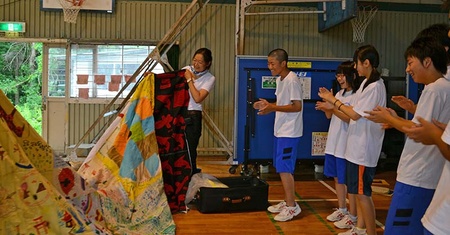After touring around Japan for almost two years in support of the victims of the 3/11 tsunami in Tohoku, showing in 55 locations, Linda Ohama’s Cloth Letter exhibition is coming back to Canada where it began.
The Canadian cloth letter exhibition tour begins July 8 - 22 in Vancouver, B.C. with cloth letters displayed at the YMCA (Burrard Street); Artists for Kids (Lonsdale Avenue); National Nikkei Centre (Burnaby); the Murakami Museum at the Britannia Heritage Shipyard (Richmond B.C.); and the main exhibition at the HSBC Pendulum Gallery (downtown Vancouver), including a performance by Chibi Taiko.
There are plans for exhibitions in Ottawa, Toronto, Whitehorse, Winnipeg, Montreal, Leduc, Peace River, Thunder Bay, Halifax, and Los Angeles.
* * * * *
I will never forget the morning of 3/11 when I saw the first unbelievable images on CBC TV coming from familiar places in Tohoku where I had lived for nine years, being wiped out by the tsunami.
It was just a matter of a few days after the disaster when I had first heard of Linda’s fundraising idea that evolved into the successful event at the Queen Elizabeth Theatre in Vancouver with classical pianist Jon Kimura-Parker and a number of other musical groups.
I remember the seed of the idea—Linda wanted to collect cloth squares from school kids from across Canada that would contain messages of support for the victims. They would be sewn together and sent to Japan.
Without any prompting, my students brought in square pieces of cloth, as well as scrap red and black cloth from home. Even though we didn’t have any particular theme in mind at first those squares took on a distinctively Canadian theme as Hala almost subconsciously began cutting out the the first red maple leafs. Then, the other girls, including Viju, Nirali, and Abigail, the artsy ones, and boys, Ateeb and Sanad, followed suit, giving up precious recess time to carefully sew their squares in a quiet circle, in our sweltering portable, listening to “roots rock reggae”.
“KIZUNA”: UNITED AS ONE
Even now, on the eve of the Canadian tour, I am reminded that the seed and the subsequent spirit that grew out of a child’s idea is not a uniquely Canadian one.
As a teacher and writer, I was always mindful that many of the families of my students had suffered devastating losses during the December 26, 2004 tsunami that took more than 230,000 lives in 14 southeast Asian countries, and other subsequent global disasters. My students rallied around me when I needed them most.
As part of the school board’s 2011 Education Week assembly a month later, my class sang “What the World Needs Now Is Love” by Burt Bacharach. With images of the disaster showing overhead, the entire school of 900 silent, the principal weeping openly, other teachers wiped away tears too. And, for one precious moment, my global community, which includes Toronto, Mississauga, Sendai, Minamisoma, Matsushima, Vancouver, Seattle, Tokyo, and the myriad of other towns and villages in Tohoku that I fondly remember, became one.
* * * * *
Q: First of all, welcome back. At how many locations were the letters displayed?
From June 2011 to February 2013, the cloth letters have been displayed in over 55 locations in Japan. Who would have ever imagined that they would grow so large and travel so far and for so long.
The project grew from three original Canadian cloth letter quilts to over 30 large quilts, as young people all over Tohoku and Japan joined the project and added their letters.
The cloth letters were first displayed in Japan hanging off the bars of gymnasium windows in Yuriage, Miyagi-ken.
The students of Yuriage Junior High School were the first to see our Canadian cloth letters, as we prepared for Canada Day on July 1, 2011, the official launch of this project in Tohoku and Japan.
These students had just lost their own school, fourteen classmates, and their homes to the giant tsunami. In July, these Yuriage teenagers were living in a community center shelter and bussing to a temporary school in a nearby town.

First display of cloth letters, hanging from the window bars in the gym of the temporary shared school for the Yuriage Junior High students who lost their own school and 14 students to the tsunami
Q: What was the reaction of the students?
I will never forget that first day.
As the large cloth letters from Canada unfolded, the students started to smile, then giggle, and finally laughed and clapped louder and louder as they saw more. What a magical moment to share with them. Seeing their happiness made me realize that something special was in these cloth letters—the care and love from other kids.
The Yuriage students responded by making their own cloth letter messages to Canadians and this was the beginning of the Tohoku cloth letter side of the project.
In that summer of 2011, the Canadian cloth letters would travel to young people throughout the disaster area of Miyagi, Iwate, and Fukushima kens and nine new Tohoku cloth letters quilts joined the project.
Q: Any names and organizations that deserve special recognition?
This grassroots project has been so successful because so many individuals, cities, and groups joined together to make it happen.
Some of the key supporters include: Canadian Fishing Company (Vancouver) who helped ship the original cloth letters to Japan, and the students from York House School (Vancouver) who fundraised to help purchase painting supplies for over 700 students to make their Tohoku cloth letters.
Our Japan co-ordinator was Misaki Nagao of Onomichi, Hiroshima and our coordinator for the Tohoku area was Tsutomu Nambu of Sendai. Both of these volunteers were invaluable in moving this project around Japan so successfully.
Q: Any reflections on what the cloth letter tour meant to the Japanese?
It always surprised me how moved the Japanese were to see the cloth letters. It seemed to help them feel that they are not alone or forgotten, that someone cared. And it became a way for the Japanese to express themselves too. A simple idea that fit.
© 2013 Norm Ibuki

















